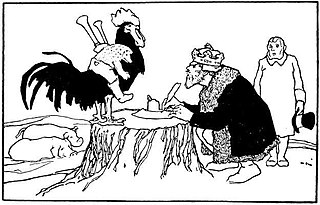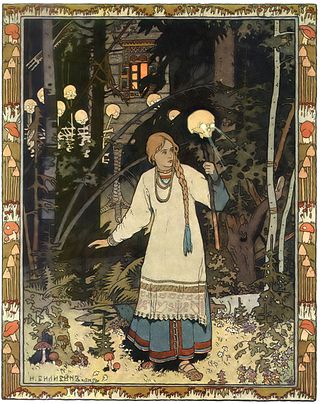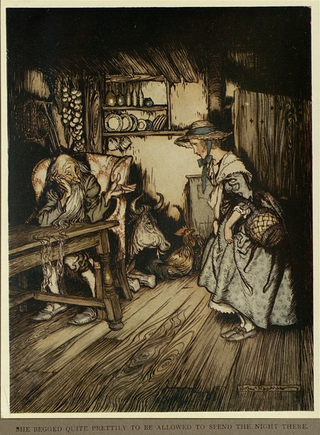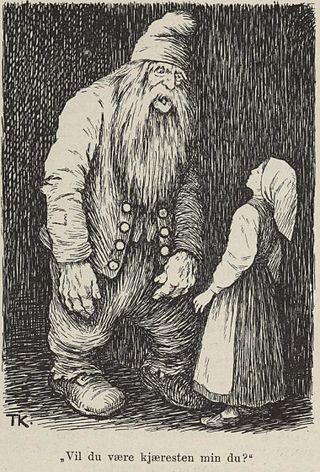
"The Golden Goose" is a fairy tale collected by the Brothers Grimm.

"Hans My Hedgehog" is a German fairy tale collected by the Brothers Grimm. The tale was translated as Jack My Hedgehog by Andrew Lang and published in The Green Fairy Book. It is of Aarne-Thompson type 441.

"The Juniper Tree" is a German fairy tale published in Low German by the Brothers Grimm in Grimm's Fairy Tales in 1812. The story contains themes of child abuse, murder, cannibalism and biblical symbolism and is one of the Brothers Grimm's darker and more mature fairy tales.
The Red Ettin or The Red Etin is a fairy tale collected by Joseph Jacobs. It was included by Andrew Lang in The Blue Fairy Book.

Vasilisa the Beautiful or Vasilisa the Fair is a Russian fairy tale collected by Alexander Afanasyev in Narodnye russkie skazki.

The youngest son is a stock character in fairy tales, where he features as the hero. He is usually the third son, but sometimes there are more brothers, and sometimes he has only one; usually, they have no sisters.

"The Three Little Men in the Wood" or "The Three Little Gnomes in the Forest" is a German fairy tale collected in 1812 by the Brothers Grimm in Grimm's Fairy Tales. Andrew Lang included it in The Red Fairy Book (1890) as "The Three Dwarfs," and a version of the tale appears in A Book of Dwarfs (1964) by Ruth Manning-Sanders.

"The Hut in the Forest" is a German fairy tale collected by the Brothers Grimm. Andrew Lang included it in The Pink Fairy Book (1897). It is Aarne-Thompson type 431.
"The Three Little Birds" is a German fairy tale collected by the Brothers Grimm, tale number 96. The story is originally written in Low German. It is Aarne-Thompson type 707, the dancing water, the singing apple, and the speaking bird. The story resembles Ancilotto, King of Provino, by Giovanni Francesco Straparola, and The Sisters Envious of Their Cadette, the story of the 756th night of the Arabian Nights.

The Battle of the Birds is a Scottish fairy tale collected by John Francis Campbell in his Popular Tales of the West Highlands. He recorded it in 1859 from a fisherman near Inverary, John Mackenzie and was, at the time, building dykes on the Ardkinglas estate. Joseph Jacobs took it from there for his Celtic Fairy Tales and added some additional elements.
The Adventures of Covan the Brown-haired is a Celtic fairy tale translated by Dr. Macleod Clarke. Andrew Lang included it in The Orange Fairy Book.
Molly Whuppie is an English language fairy tale set in Scotland. It was first published in 'Three Folk-Tales from Old Meldrum, Aberdeenshire' in "Folklore" (6.2.1884). Rev. Walter Gregor said that the tales had been 'communicated to me by Mr. Moir, Rector of the Grammar School, Aberdeen. He had them from his mother, who kindly wrote out " Mally Whuppie " and " The Red Calf" at my request.' Anglicising the name to "Molly" from "Mally" Joseph Jacobs used this source of the story in his English Fairy Tales. A Highland version, Maol a Chliobain, was collected by John Francis Campbell in Popular Tales of the West Highlands. Jacobs noted the relationship between the two tales, and an Irish variant, "Smallhead," and concluded that the tale was Celtic in origin.
Jack and His Golden Snuff-Box is a Romani fairy tale collected by Joseph Jacobs in English Fairy Tales. He listed as his source Francis Hindes Groome's In Gypsy Tents.

The Feather of Finist the Falcon or Finist the Falcon is a Russian fairy tale collected by Alexander Afanasyev in Narodnye russkie skazki. It is Aarne–Thompson type 432, the prince as bird. Other tales of this type include The Green Knight, The Blue Bird, and The Greenish Bird.
The Three Daughters of King O'Hara is an Irish fairy tale collected by Jeremiah Curtin in Myths and Folk-lore of Ireland. Reidar Th. Christiansen identified its origin as County Kerry.
The King of Love is an Italian fairy tale from Sicily collected by Giuseppe Pitre and translated into English by Thomas Frederick Crane in Italian Popular Tales.

"The Old Dame and her Hen" is the English title given by Dasent to the Norwegian folk tale, Asbjørnsen and Moe’s number 35.
Der Sohn der Teriel is a Berber folktale, first collected in Kabylia in German by ethnologist Leo Frobenius and published in 1922.
The Story of Princess Zeineb and King Leopard is a French language fairy tale published in the 18th century. The tale belongs to the international cycle of the Animal as Bridegroom as a subtype, with few variants reported across Europe.
The Green Man of Knowledge is a Scottish folktale collected in 1954 and published in 1958, in the academic journal Scottish Studies. It is classified in the international Aarne-Thompson-Uther Index as tale type ATU 313, "Girl Helps the Hero Flee" or "The Magic Flight".









